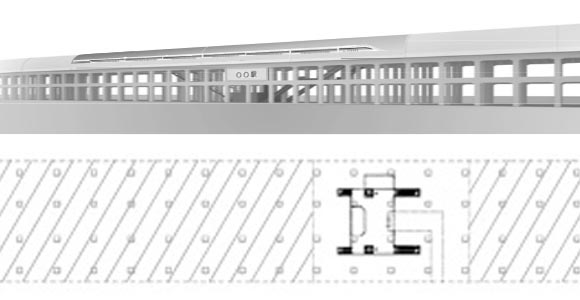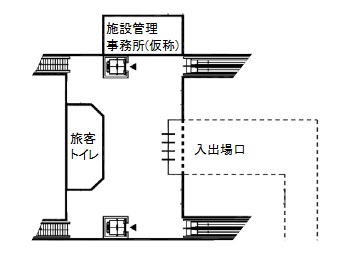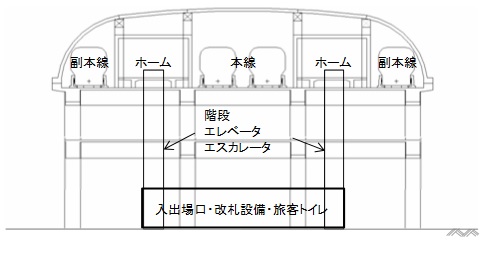 On 13 May, JR Central released station design plans for their upcoming Chuo Shinkansen running from Tokyo to Nagoya and later Osaka. In the words of JR, these stations were designed “not to rely on traditional styles” and “to boldly pursue functionality and efficiency.”
On 13 May, JR Central released station design plans for their upcoming Chuo Shinkansen running from Tokyo to Nagoya and later Osaka. In the words of JR, these stations were designed “not to rely on traditional styles” and “to boldly pursue functionality and efficiency.”
However, when the details emerged to a train station loving public, the reaction was less than enthusiastic with comments along the line of “too bold.”
The Chuo Shinkansen is called a “Linear Line” which is the Japanese term for a maglev (magnet propelled train). The new shinkansen will begin shuttling people between Tokyo and Nagoya in 2027. By 2045, the line should be extended to Osaka.
Here’s the floor plan for a station along this line:
And that’s it – just a set of elevators, escalators and stairs. There are also some lavatories, a gate, and a “facilities management office.” For Japanese people, this is a far cry from the bento stands, temperature controlled waiting areas, and station workers popping out of secret doors by the ticket machines that they’re used to.
In fact, JR said that there will be no full-time staff working at these types of stations. This is all in an effort to reduce the burden of operating, property, and construction costs for local governments that the Chuo Shinkansen passes through.
Tickets for this line will be by reservation only, but the system by which tickets can be reserved and purchased hasn’t been sorted out yet.
Looking at the Spartan diagrams, netizens chimed in saying, “that’s too primitive to even be called a station.” Another net user commented that this was JR getting revenge on local governments.
“Local governments are supposed to pay 1/3 the construction costs of Shinkansen lines, but there is absolutely no burden on them for the Linear Chuo Shinkansen. I think that JR Central approached the governments, they resisted, and in the end we have stations with only platforms and a toilet.”
There is still a long time before the station opens in 14 years and JR had announced that these designs could be built upon. So, it could very well be that this is simply a negotiation tactic reminding the governments of the revenue and job creation a station brings to communities.
Source: JR Central 1, 2 (Japanese) via IT Media (Japanese)
▼ Other angles of the proposed stations




 Not so fast! Japan’s super-high-speed maglev Shinkansen line opening has been officially delayed
Not so fast! Japan’s super-high-speed maglev Shinkansen line opening has been officially delayed New way to buy Shinkansen tickets, through messaging app, coming this fall
New way to buy Shinkansen tickets, through messaging app, coming this fall Nozomi Shinkansen bullet train abolishes low-priced unreserved tickets during peak travel seasons
Nozomi Shinkansen bullet train abolishes low-priced unreserved tickets during peak travel seasons Japan travel alert: Cheapest seats on fastest Shinkansen will not be offered for Golden Week
Japan travel alert: Cheapest seats on fastest Shinkansen will not be offered for Golden Week Final Fantasy and Shinkansen announce collaboration with in-train audio play, SD art and merch
Final Fantasy and Shinkansen announce collaboration with in-train audio play, SD art and merch Japanese beef bowl chain Sukiya’s 2026 Smile Box lucky bag basically pays for itself
Japanese beef bowl chain Sukiya’s 2026 Smile Box lucky bag basically pays for itself We revisited Sweets Paradise after a decade to see if Japan’s dessert buffet still delivers
We revisited Sweets Paradise after a decade to see if Japan’s dessert buffet still delivers Survey finds more than 70 percent of Japanese children have an online friend
Survey finds more than 70 percent of Japanese children have an online friend What’s it really like to climb Mt Fuji?
What’s it really like to climb Mt Fuji? 7-Eleven Japan’s ramen-cooking robot whipped us up a bowl of noodles【Taste test】
7-Eleven Japan’s ramen-cooking robot whipped us up a bowl of noodles【Taste test】 What’s the best way to spend 1,000 yen at the Seria 100-yen chainstore in Japan?
What’s the best way to spend 1,000 yen at the Seria 100-yen chainstore in Japan? Burgers soaked in a plate of hot cheese served at American Diner Andra in Tokyo
Burgers soaked in a plate of hot cheese served at American Diner Andra in Tokyo Shake Udon one-hand takeout bukkake noodle cups look to shake udon eating in Japan【Taste test】
Shake Udon one-hand takeout bukkake noodle cups look to shake udon eating in Japan【Taste test】 Cup Noodle tries an authentic Jiro-style ramen, but something’s not quite right
Cup Noodle tries an authentic Jiro-style ramen, but something’s not quite right We take a ride on Seibu Railway’s futuristic luxury liner: the Limited Express Laview
We take a ride on Seibu Railway’s futuristic luxury liner: the Limited Express Laview Starbucks Japan ready to get Year of the Horse started with adorable drinkware and plushies【Pics】
Starbucks Japan ready to get Year of the Horse started with adorable drinkware and plushies【Pics】 Hayao Miyazaki says Happy New Year to Studio Ghibli fans with new art for Year of the Horse
Hayao Miyazaki says Happy New Year to Studio Ghibli fans with new art for Year of the Horse 7 great places to see Mt. Fuji from without having to climb it
7 great places to see Mt. Fuji from without having to climb it We found possibly the quietest Japanese-style hotel in Tokyo’s bustling Shinjuku district
We found possibly the quietest Japanese-style hotel in Tokyo’s bustling Shinjuku district Hello Kitty Choco Egg figures are an adorable trip through three periods of Japanese pop culture【Pics】
Hello Kitty Choco Egg figures are an adorable trip through three periods of Japanese pop culture【Pics】 Japan’s oldest largetooth sawfish in captivity back on display in Mie Prefecture
Japan’s oldest largetooth sawfish in captivity back on display in Mie Prefecture Cyberpunk anime meets traditional culture in Ghost in the Shell gold leaf Japanese changing screens
Cyberpunk anime meets traditional culture in Ghost in the Shell gold leaf Japanese changing screens The best Starbucks Japan Frappuccinos we want to drink again in 2026
The best Starbucks Japan Frappuccinos we want to drink again in 2026 7-Eleven Japan starts new temporary luggage storage service in over 300 branches
7-Eleven Japan starts new temporary luggage storage service in over 300 branches Disillusionment at Tsukiji’s tourist-target prices led us to a great ramen restaurant in Tokyo
Disillusionment at Tsukiji’s tourist-target prices led us to a great ramen restaurant in Tokyo Starbucks teams up with 166-year-old Kyoto doll maker for Year of the Horse decorations【Photos】
Starbucks teams up with 166-year-old Kyoto doll maker for Year of the Horse decorations【Photos】 Tokyo considering law requiring more trash cans following litter increase in heavily touristed area
Tokyo considering law requiring more trash cans following litter increase in heavily touristed area Tokyo’s Tsukiji sushi neighborhood asks tour groups to stay away for the rest of the month
Tokyo’s Tsukiji sushi neighborhood asks tour groups to stay away for the rest of the month Tokyo event lets you travel back in time, for free, to celebrate 100 years since Showa era start
Tokyo event lets you travel back in time, for free, to celebrate 100 years since Showa era start Sanrio theme park in Japan announces plans to expand into a Sanrio resort
Sanrio theme park in Japan announces plans to expand into a Sanrio resort Japan may add Japanese language proficiency, lifestyle classes to permanent foreign resident requirements
Japan may add Japanese language proficiency, lifestyle classes to permanent foreign resident requirements Stamina-destroying “Paralysis Noodles” are Tokyo’s newest over-the-top ramen innovation
Stamina-destroying “Paralysis Noodles” are Tokyo’s newest over-the-top ramen innovation Survey asks foreign tourists what bothered them in Japan, more than half gave same answer
Survey asks foreign tourists what bothered them in Japan, more than half gave same answer Japan’s human washing machines will go on sale to general public, demos to be held in Tokyo
Japan’s human washing machines will go on sale to general public, demos to be held in Tokyo Japan’s deadliest food claims more victims, but why do people keep eating it for New Year’s?
Japan’s deadliest food claims more victims, but why do people keep eating it for New Year’s? We deeply regret going into this tunnel on our walk in the mountains of Japan
We deeply regret going into this tunnel on our walk in the mountains of Japan Studio Ghibli releases Kodama forest spirits from Princess Mononoke to light up your home
Studio Ghibli releases Kodama forest spirits from Princess Mononoke to light up your home Major Japanese hotel chain says reservations via overseas booking sites may not be valid
Major Japanese hotel chain says reservations via overseas booking sites may not be valid Put sesame oil in your coffee? Japanese maker says it’s the best way to start your day【Taste test】
Put sesame oil in your coffee? Japanese maker says it’s the best way to start your day【Taste test】 No more using real katana for tourism activities, Japan’s National Police Agency says
No more using real katana for tourism activities, Japan’s National Police Agency says Starbucks Japan reveals new sakura drinkware collection, inspired by evening cherry blossoms
Starbucks Japan reveals new sakura drinkware collection, inspired by evening cherry blossoms Updated cherry blossom forecast shows extra-long sakura season for Japan this year
Updated cherry blossom forecast shows extra-long sakura season for Japan this year Potentially dirty and broken used Shinkansen food/beverage carts on sale in Japan for 100,000 yen
Potentially dirty and broken used Shinkansen food/beverage carts on sale in Japan for 100,000 yen Tokaido Shinkansen removing smoking rooms, going entirely smoke-free
Tokaido Shinkansen removing smoking rooms, going entirely smoke-free Shinkansen will require reservations for large suitcases, charge penalty fees for those without
Shinkansen will require reservations for large suitcases, charge penalty fees for those without Free Shinkansen tickets for kids travelling with parents during special JR promotion
Free Shinkansen tickets for kids travelling with parents during special JR promotion Shinkansen bullet trains adding semi-private booths on most popular travel route【Pics】
Shinkansen bullet trains adding semi-private booths on most popular travel route【Pics】 Here’s your chance to ride Japan’s maglev Shinkansen in spring, nine years before service starts
Here’s your chance to ride Japan’s maglev Shinkansen in spring, nine years before service starts What to do if you forget your camera or other belongings on the Shinkansen
What to do if you forget your camera or other belongings on the Shinkansen More Shinkansen trains being added to Japan’s “golden route” to meet traveler demand
More Shinkansen trains being added to Japan’s “golden route” to meet traveler demand Shinkansen to permanently reduce number of inexpensive non-reserved seats on Nozomi trains
Shinkansen to permanently reduce number of inexpensive non-reserved seats on Nozomi trains Shinkansen bullet train tickets go half-off until spring of next year in east Japan travel push
Shinkansen bullet train tickets go half-off until spring of next year in east Japan travel push New private rooms on Tokaido Shinkansen change the way we travel from Tokyo to Kyoto
New private rooms on Tokaido Shinkansen change the way we travel from Tokyo to Kyoto Human body parts found in crack on bonnet of Shinkansen bullet train
Human body parts found in crack on bonnet of Shinkansen bullet train Tokyo farewells Japan’s only double-decker Shinkansen with a special escalator at the station
Tokyo farewells Japan’s only double-decker Shinkansen with a special escalator at the station JR East announces awesomely cheap one-day all-you can ride pass, Shinkansen included
JR East announces awesomely cheap one-day all-you can ride pass, Shinkansen included Tokaido Shinkansen ending in-train food/drink sales for all non-first-class-passenger cars
Tokaido Shinkansen ending in-train food/drink sales for all non-first-class-passenger cars Japan Railways to test weak air conditioning in some Shinkansen cars this summer
Japan Railways to test weak air conditioning in some Shinkansen cars this summer Shinkansen zombie outbreak occurring for first-ever haunted bullet train event
Shinkansen zombie outbreak occurring for first-ever haunted bullet train event
Leave a Reply